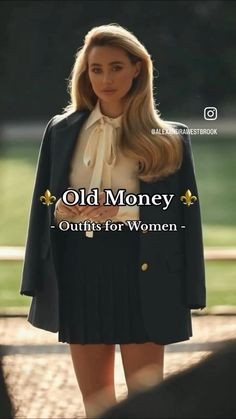Embracing Elegance: The Allure of Old Money Outfits
Old money outfits have long symbolized a refined, understated elegance that speaks to a sophisticated understanding of style. This classic fashion ethos, which prioritizes quality over flashiness, has a unique charm rooted in a deep-seated appreciation for tradition and heritage. In this article, we'll delve into the essence of old money fashion, exploring its key elements, historical context, and how you can incorporate these timeless principles into your wardrobe today.
Understanding Old Money Fashion
Old money fashion is defined by its commitment to understated luxury. Unlike contemporary trends that often chase the latest fads, old money attire remains consistent in its approach: timeless, classic, and discreetly opulent. The core principle of old money style is to convey wealth and sophistication without overt displays of affluence.
1. Quality Over Quantity
The hallmark of old money fashion is its focus on high-quality materials. Fabrics such as cashmere, silk, and wool are preferred for their durability and luxurious feel. Tailoring is another crucial element, as garments are often custom-made or tailored to fit perfectly, emphasizing the wearer's attention to detail and commitment to refinement.
2. Timeless Silhouettes
Old money outfits favor classic silhouettes that transcend fleeting trends. For men, this might mean well-fitted suits with a tailored jacket and flat-front trousers. For women, it could involve elegant dresses with a focus on fit and subtle embellishments. Patterns such as houndstooth, pinstripes, and plaid are common, as they evoke a sense of history and tradition.
3. Subdued Color Palettes
Colors in old money fashion are typically muted and sophisticated. Neutral tones such as navy, gray, beige, and deep greens dominate, complemented by subtle accents of more vibrant colors like burgundy or royal blue. The idea is to create a cohesive, polished look without relying on bold, flashy hues.
4. Classic Accessories
Accessories in old money fashion are often understated yet refined. For men, this includes classic wristwatches, leather belts, and silk ties with minimal patterns. For women, pearls, leather handbags, and simple gold or silver jewelry are staples. These accessories are chosen for their quality and ability to enhance the overall outfit without overpowering it.
Historical Context and Evolution
The concept of old money fashion can be traced back to the 19th and early 20th centuries, a time when aristocracy and landed gentry were prominent. During this era, fashion was a key indicator of social status and refinement. Old money families, who had inherited their wealth through generations, adhered to strict fashion codes that emphasized elegance and subtlety.
In the 1920s and 1930s, the old money style began to take shape more distinctly. Figures like Coco Chanel popularized the "little black dress," a timeless piece that epitomized the elegance of old money fashion. Meanwhile, the Duke of Windsor became known for his impeccable tailoring and classic menswear, further solidifying the style's reputation.
As the mid-20th century progressed, old money fashion continued to evolve while maintaining its core principles. The post-World War II era saw the rise of American Ivy League style, which incorporated elements of old money aesthetics into everyday wear. Designers like Ralph Lauren drew inspiration from this classic style, blending it with contemporary trends to create modern interpretations.
Incorporating Old Money Style Today
Adopting old money fashion principles today involves embracing a mindset of quality, restraint, and sophistication. Here are some practical tips for integrating these timeless elements into your wardrobe:
Invest in Quality Pieces: Focus on acquiring a few high-quality, versatile items rather than a large quantity of trendy garments. Look for well-made clothing from reputable brands or consider bespoke options for a perfect fit.
Choose Classic Cuts and Fabrics: Opt for traditional silhouettes and fabrics that have stood the test of time. For example, a well-tailored blazer, a cashmere sweater, or a pair of leather loafers can form the foundation of a refined wardrobe.
Embrace Neutral Colors: Build your wardrobe around a palette of muted, classic colors that can be easily mixed and matched. This creates a cohesive look and allows individual pieces to shine without clashing.
Prioritize Subtle Accessories: Select accessories that enhance your outfit without dominating it. A simple leather belt, a classic watch, or a pair of understated stud earrings can add a touch of elegance to your ensemble.
Maintain a Polished Appearance: Old money fashion is not just about clothing but also about presentation. Ensure your clothes are well-maintained, clean, and neatly pressed. Attention to grooming and personal hygiene also plays a crucial role in achieving a polished look.
Conclusion
Old money outfits embody a style of elegance that transcends time and trends. By focusing on quality, timeless silhouettes, and understated sophistication, you can capture the essence of this classic fashion ethos. Whether you're looking to elevate your everyday wardrobe or prepare for a special occasion, embracing the principles of old money fashion offers a way to express your refined taste and appreciation for timeless elegance.






